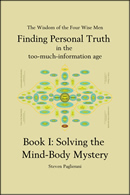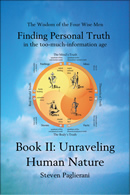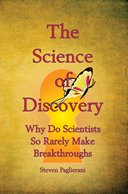
.png)
Excerpts from The Science of Discovery (why do scientists so rarely make breakthroughs?)
It has now been close to a decade since I wrote this book. I'm still surprised by much of what I discovered as I wrote it. But surprises are my stock in trade, my daily bread, my living. So my doing this is something I've come to accept as my way of life.
What more surprises me is that I've admitted to the world that I've written a new scientific method, a method based on two new maths, a math which measures quantity and a math which measures quality. And if none of this interests you, I am not surprised. Just know that my proof for everything else I write about is based on how this scientific method has processed my evidence. So were you to truly want to test my theories, this book would be where you'd need to begin.
Fortunately, you need not read the theory part in order to enjoy the many discoveries. That I look at the world through theeyes of a six year old only makes it more fun. And who doens't want to understand why we gain weight, how we get cancer, and how sleep works. The truth. Not the half truths the old science offers.
Am I being too bold? Perhaps I am. Then again, perhaps you can reserve judgement until you can look for yourself. And if you find yourself disagreeing with what I've said? If you've acutally read what I've said, then you've earned the right to me I'm wrong. If not, then I'm afraid you haven't. At least, in my eyes.
.png)
Science’s Holy Grail: Discoveries
Everything scientists do is intended to lead to discoveries. No coincidence, we reward scientists who make meaningful discoveries with things like the Nobel Prize. In a way then, discoveries are the universal holy grail of science. Yet strangely, close to 100% of the efforts scientists make fail to discover anything. Why? And why does no one ever mention this?
This is not to say scientists discover nothing, let alone nothing meaningful. Not a single life on this planet has been left untouched by science’s advancements. Moreover, scientists themselves are some of the brightest, most hard working people I know. So how do we explain this close to perfect record of failures?
This book will allege these failures are due to faults in the scientific method. Some proof for this lies in the retorts people make whenever I suggest this. Indeed, most times, questioning science’s methods seems tantamount to questioning religious people about God’s will. To wit, when asked to discuss their method, not a single scientist has been willing to talk me through it—at least, not scientifically.
If the method is truly scientific, then why do people get so defensive when asked these questions?
How SSRIs Treat Depression: an Analogy
Nerve cells function like phone lines. They carry messages, each cell in one direction. And when it comes to brain cells, scientists tell us they do this in two ways, electrically—within cells, and chemically—between cells. The word neurotransmitter refers to the chemicals which transmit messages between nerve cells. And serotonin is one of these chemical messengers.
Now to see how this works, imagine you're at a baseball game. Currently the ball is in the pitcher's glove, and the catcher's glove is open. Now look at the drawing of the two nerve cells I've placed above. Can you see how each cell contains both a pitcher and a catcher?
Real neurons function quite similarly to this baseball game analogy. At the pitcher's end of a cell, there are little “gloves” which hold, throw, and catch-back serotonin. At the catcher's end of a cell, then, there are little catcher's gloves which catch, hold, and return the serotonin to the pitcher end of the previous a cell.
The main thing to know here is what happens when a pitcher in one cell throws serotonin to the catcher in the next cell. A message gets forwarded from the first cell to the second. Once received, the second cell then sends an internal electrical signal from its catcher to its pitcher. In this way, each cell forwards the message on to the next cell. And so on and so forth, down the line, until the message gets delivered.
Why the baseball analogy? Because of what the two cells do next. The catcher end of the second cell returns the ball to the pitcher end of the first cell. Thus, just like a baseball game, wherein the ball gets used again and again, the body reuses the serotonin, over and over again.
This second part of the message-sending process is called “reuptake.” During reuptake, the first cell reabsorbs the serotonin it previously sent to the second cell. How SSRIs work is that they interfere with reuptake, thus slowing down this part of the process. This causes the returning serotonin to linger in the space in between cells.
Why does this matter? Because we're only alert to possible messages when the serotonin is in that space. This is similar to how we feel when the ball is in the air at the ball game. We feel anticipatory excitement. So while SSRIs do not increase our actual serotonin levels, they increase the amount of time that we are aware of the serotonin we do have. At the same time, they interfere with our ability to sense time quickly.
The point, of course, is that this is how SSRI's help people with depression. By inhibiting reuptake, they fool the body into thinking it has more serotonin than it does. Moreover, in general, the more people sense serotonin in these spaces, the more alert they become. And hopefully, the more alert they become, the less depressed they feel.
Setting aside any flaws in this logic, can you see how sensing more serotonin might interfere with sleep? Serotonin excites things, remember? And this alertness can interfere with sleep. No surprise, a common side effect of taking an SSRI is insomnia, at least while people get used to taking it. In fact, I once took an SSRI for the symptoms of a bad break-up. After not being able to sleep for four days, I had to go off it.
The insomnia hurt more than the break-up.
Should We Finish Our Food or Not?
One clue to this puzzle may lie in the differences between young children and the rest of us. By this, I mean, the differences between what young children get told about food and exercise versus what we tell ourselves. We tell ourselves we must eat less and exercise more. And this makes sense. The two main factors in how much we weigh appear to be how much we eat and how much exercise we do. Ironically, normal young children—the largest group of humans to be, by nature, thin—are told the very opposite of what we are told.
We are told to eat less and to exercise more, remember? But most young children are told to finish their food (to eat more) and to stop running around (to exercise less).
Here then is one of the more intriguing observations we might make about age, weight, and the mind. And it all centers on what young children are told about eating and exercise versus what we tell ourselves. Again, young children are told they must FINISH their food and STOP running around. Whereas we tell ourselves to NOT FINISH our food, and to START running around.
What makes me think these two pairs of opposites (what we tell ourselves about eating and exercise vs what children are told) are so significant? After all, can’t it simply be normal for most young children to be thin—and natural for us to get fatter as we age? In truth, to a point, being thin at a young age is normal. Obviously, it’s also natural for us to gain weight as we age. But the real question is, is it natural for us to become overweight as we age? Or is excess weight gain the evidence that we’re doing something wrong?
Questions. Questions. Questions. Already, we're off to a good start.
Books by Steven Paglierani



.png)